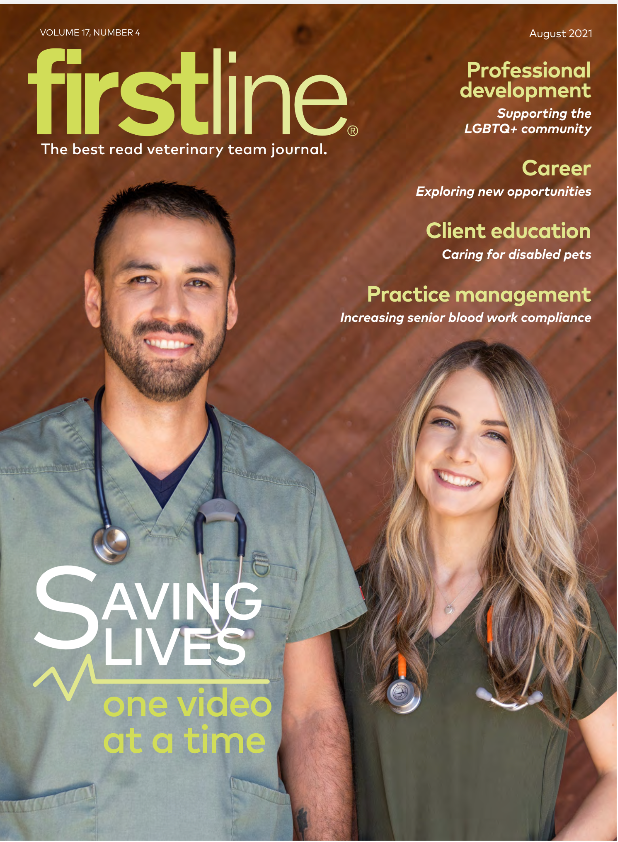Supporting your veterinary team starts by cultivating a more accepting, diverse, and inclusive workspace that everyone can flourish in.
“It makes a tremendous amount of impact to know that someone sees you for who you authentically are and that they support you in that,” said Dane Whitaker, DVM, MPVM, president of PrideVMC, about showing allyship.
At the 2021 virtual Veterinary Meeting & Expo (VMX), Whitaker along with Abby McElroy, DVM, MS, president-elect of PrideVMC, and Deborah T. Kochevar, DVM, PhD, DACVCP, PrideVMC board member, discuss the significance of allyship and how to “show up” for the LGBTQ+ population. The trio highlights 3 methods for demonstrating your support in the veterinary community, and beyond.
Supporting the LBGTQ+ population in a veterinary practice
Whitaker highlights ways for incorporating the methods listed above to display allyship specifically in the veterinary profession:
- Include pronouns on name badges
- Incorporate gender-neutral bathrooms
- Offer diversity training
- Recognize your privilege
- Be committed to educating yourself
Understanding allyship
According to Kochevar, to be an ally and friend to LGBTQ+ colleagues, it is essential to understand the key traits of what makes an ally. She pinpoints the following characteristics:
- Being an open-minded, caring listener.
- Recognizing your privilege and using it for good.
- Asking educated questions and doing your own research.
- Getting comfortable being uncomfortable. You will make mistakes. Dealing with it and moving on.
- Speaking up for the under-represented. Knowing what that means and how to do it.
- Ensuring you do not overshadow or occupy a queer person’s right to speak up for themselves.
- Resisting the need for validation.
- Diversifying and expanding your own and your kids’ reading and watch lists.
“When I think of being an ally and being a friend, these rules apply pretty much to all your interactions, it’s almost the golden rule,” said Kochevar. “If you feel you’re being treated well and you behave that way towards others, then you’re usually on pretty solid ground.”
LGBTQ+ terminology
McElroy explains that educating and familiarizing yourself with common LGBTQ+ associated terms is another great way to show allyship. Especially when using the terms correctly. “While people often lump these [terms] together, they are very different,” she added.
To help, McElroy provided attendees with common terms and their definitions:
- Gender identity: Your internal sense of self and your gender (eg, female, woman, girl, male, man, boy, other gender(s)).
- Gender expression: How you present your gender to the world (eg, feminine, masculine, other).
- Sex assigned at birth: Typically based on someone’s external physical features at birth (eg, female, male, other/intersex).
- Physically attracted to: Your sexual orientation, which may or may not be who you are emotionally attracted to (eg, women, men, other gender(s)).
- Emotionally attracted to: Your sexual orientation, which may or may not be the same as who you are physically attracted to (eg, women, men, other gender(s)).
“There are a lot of terms associated with the LGBTQ+ community and we know they’re confusing when you’re first learning about the community. I think people become very anxious about using the wrong term. We want to allay some of these fears and explain some of these terms,” explained McElroy.
Appropriate use of pronouns
One of the most important things you can do to demonstrate your understanding of personal pronouns is to properly use pronouns and address others by their correct pronouns. According to Whitaker, this action demonstrates your awareness of why pronouns are important to the LGBTQ+ community. “Respecting someone’s pronouns is one of most basic ways to show you respect their gender identity,” said Whitaker.
Additionally, he adds that although “they/them/theirs” are the most common gender-neutral pronouns, it’s crucial to be mindful that sometimes people create their own pronouns.
To help attendees practice appropriate allyship, Whitaker outlined several general rules regarding the do's and don’ts of pronoun use.
Do’s
He advises getting into the habit of introducing yourself with your pronouns. This can be done in a variety of ways including verbal form, written form, or with an email signature, business card, or name tag in the veterinary practice.
Don’ts
Conversely, Whitaker urges not to put others on the spot by asking their pronouns unless you ask everyone because some might not be as comfortable with their pronouns yet. Instead, he encourages you to lead the conversation with your own pronouns as this can invite others to follow with their pronouns if they wish. He also mentions not to refer to your pronouns as “preferred pronouns,” because this implies that using these pronouns is optional.
Whitaker notes that it is okay to make mistakes—they happen to everyone and the best course of action to take if this occurs is to apologize and move on. Gender privilege is not having to worry about the pronoun(s) someone will label you with; to be an ally, it’s vital to understand your privilege and stand up for others who may not have the same.

